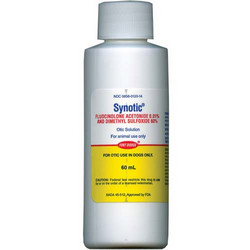Synotic Otic Solution
+ Save on each recurring order!
Free Shipping on orders over $75
Low Price Match Guarantee
- Used for edema, inflammation, erythema and pruritus
- Associated with scratching and excoriation
- Available Sizes
- 8 mL
- 16 mL
Description
SYNOTIC Otic Solution Veterinary is indicated for the relief of pruritus and inflammation associated with acute and chronic otitis in the dog.It decreases edema (swelling), inflammation, erythema (reddening of the skin) and pruritus, with associated scratching and excoriation. Its slow rate of evaporation allows for greater distribution and penetration to all parts of the ear.
Key Benefits
- Relieves itching and inflammation associated with acute and chronic ear infections in dogs.
- Decreases swelling, inflammation, erythema and pruritus with associated scratching and excoriation
- Slow rate of evaporation allows for greater distribution and penetration to all parts of the ear.
Administration and Dosage
The recommended dose of SYNOTIC Otic Solution Veterinary is 4 to 6 drops (0.2 mL) per ear administered twice daily into the ear canal for a maximum period of 14 days. The total dosage used should not exceed 17 mL. It is recommended that the affected ear canal be cleansed by some appropriate method prior to the instillation of the solution. Following instillation, gentle external massage of the ear canal may aid in promoting an even distribution of the medication. Care should be taken to avoid contact of the medication with the dog's eyes. Contact of the bare hand with the medication should also be avoided.
| Recommended Dosage | |
| Dose |
|
| Frequency |
|
| Application |
|
| Handling |
|
Side Effects
A transient, but mild, stinging sensation may be experienced by some animals when the solution is applied to denuded areas. The effect will disappear as healing progresses. A temporary increase in temperature of the area may also be noted. Corticosteroid therapy will generally cause a remission of signs of allergic origin. However, until the causative agent is identified and removed from the animal’s environment, the condition may recur when therapy is terminated. Ordinarily, side effects are not encountered with topically applied corticosteroids; but as with all drugs, some animals may exhibit unfavorable local and/or systemic reactions. A local reaction may be due to sensitization to the corticosteroid or one of the other components of the solution.
It is known that DMSO enhances the percutaneous absorption of topically applied corticosteroids and the veterinarian should be aware of possible systemic reactions in this situation. Accordingly, this product is contraindicated wherever systemic corticosteroids would be dangerous. Adrenal suppression, weight loss and increased susceptibility to infections may be evidenced with the use of this drug, especially in over dosage. Therefore, care should be taken to assure that the recommended dosage is not exceeded. In the presence of local and/or systemic side effects, the drug should be withdrawn. When a local reaction occurs other therapeutic measures should be instituted. Therapy can usually be resumed at a lower dose once systemic signs abate, without further recurrence of the problem. Absorption of DMSO following topical application may result in an odorous breath described as oyster or garlic-like with an unpleasant taste. Some animals and clients may find this objectionable but these effects are transient and not considered to be of serious consequence.
Precautions
There should be careful initial evaluation and follow-up of infected ears. Incomplete response or exacerbation of corticosteroid responsive lesions may be due to the presence of an infection which requires identification or antibiotic sensitivity testing, and the use of the appropriate antimicrobial agent. As with any corticosteroid, animals with a generalized infection should not be treated with this product without proper supportive antimicrobial therapy. Preparations with DMSO should not be used in pregnant animals since studies in chick embryos and guinea pigs have indicated it is teratogenic and embryotoxic.
SYNOTIC (fluocinolone acetonide and dimethyl sulfoxide) Otic Solution Veterinary is recommended for topical application to the ear canal of the dog only.
DO NOT ADMINISTER BY ANY OTHER ROUTE.
Warning
Clinical and experimental data have demonstrated that corticosteroids administered orally or by injection to animals may induce the first stage of parturition if used during the last trimester of pregnancy and may precipitate premature parturition followed by dystocia, fetal death, retained placenta, and metritis.
Additionally, corticosteroids administered to dogs, rabbits, and rodents during pregnancy have resulted in cleft palate in offspring. Corticosteroids administered to dogs during pregnancy have also resulted in other congenital anomalies, including deformed forelegs, phocomelia and anasarca.
Storage Information
Store at controlled room temperature 20°-25°C (68°-77°F) with excursions between 15°-30°C (59°-86°F).
Caution
VERY HYGROSCOPIC. CLOSE VIAL TIGHTLY AFTER USE.
Supplied
SYNOTIC® (fluocinolone acetonide and dimethyl sulfoxide) Otic Solution Veterinary available in dropper vials of 8 mL and 60 mL.
| RX required for this item. Click here for our full Prescription Policy and Form |
INDICATIONS
SYNOTIC Otic Solution Veterinary is indicated for the relief of pruritus and inflammation associated with acute and chronic otitis in the dog.
ADMINISTRATION AND DOSAGE
The recommended dose of SYNOTIC Otic Solution Veterinary is 4 to 6 drops (0.2 mL) per ear administered twice daily into the ear canal for a maximum period of 14 days. The total dosage used should not exceed 17 mL. It is recommended that the affected ear canal be cleansed by some appropriate method prior to the instillation of the solution. Following instillation, gentle external massage of the ear canal may aid in promoting an even distribution of the medication. Care should be taken to avoid contact of the medication with the dog's eyes. Contact of the bare hand with the medication should also be avoided.







